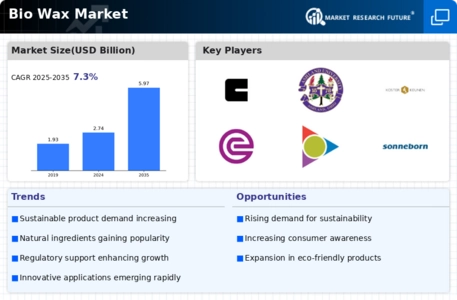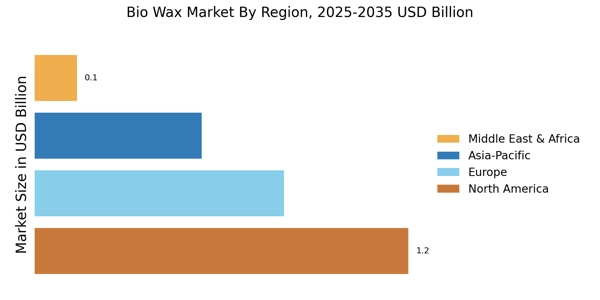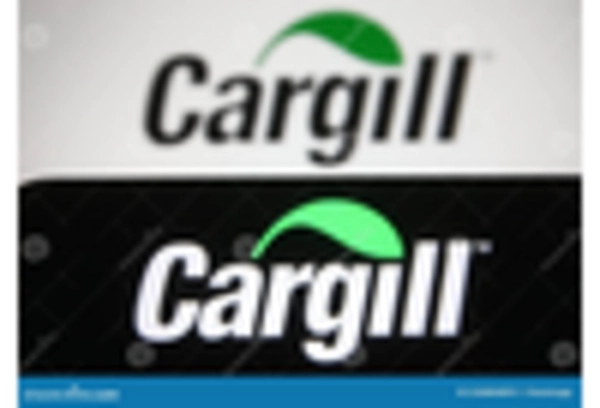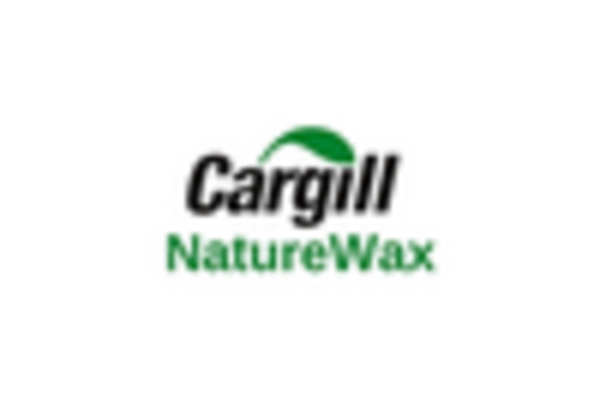Regulatory Support
Regulatory frameworks are increasingly favoring the use of bio-based products, which is likely to bolster the Bio Wax Market. Governments are implementing policies that promote the use of renewable resources and sustainable materials, thereby creating a conducive environment for bio wax manufacturers. For instance, various countries are introducing incentives for companies that produce eco-friendly products, which could enhance the market appeal of bio waxes. Furthermore, regulations aimed at reducing carbon footprints are pushing industries to seek alternatives to traditional waxes. This regulatory support is expected to drive innovation and investment in the Bio Wax Market, potentially leading to a market expansion valued at over 1.4 billion USD by 2027. The alignment of regulatory policies with market trends suggests a promising outlook for bio waxes.
Diverse Application Areas
The versatility of bio waxes is emerging as a key driver for the Bio Wax Market. These waxes are increasingly being utilized across various sectors, including cosmetics, food, and pharmaceuticals. In the cosmetics industry, bio waxes are favored for their natural properties and skin compatibility, leading to a rise in their incorporation into skincare and makeup products. Additionally, the food industry is adopting bio waxes for packaging solutions, as they provide a sustainable alternative to conventional waxes. The pharmaceutical sector is also exploring bio waxes for drug delivery systems due to their biocompatibility. This broad range of applications is likely to expand the market reach of bio waxes, contributing to an anticipated market growth of approximately 1.2 billion USD by 2026. The diverse application areas underscore the adaptability and potential of the Bio Wax Market.
Sustainability Initiatives
The increasing emphasis on sustainability appears to be a pivotal driver for the Bio Wax Market. As consumers become more environmentally conscious, there is a growing demand for products that are biodegradable and derived from renewable resources. This trend is reflected in the rising sales of bio-based waxes, which are perceived as eco-friendly alternatives to traditional petroleum-based waxes. In 2025, the market for bio waxes is projected to reach a valuation of approximately 1.5 billion USD, indicating a robust growth trajectory. Companies are investing in sustainable practices, which not only enhances their brand image but also aligns with consumer preferences for greener products. This shift towards sustainability is likely to continue influencing purchasing decisions, thereby propelling the Bio Wax Market forward.
Technological Advancements
Technological innovations are playing a crucial role in shaping the Bio Wax Market. Advances in extraction and processing technologies have led to the development of high-quality bio waxes that meet diverse consumer needs. For instance, the introduction of new refining techniques has improved the purity and performance of bio waxes, making them suitable for various applications, including cosmetics, food packaging, and candles. The market is witnessing a surge in research and development activities aimed at enhancing the properties of bio waxes, which could potentially lead to new product formulations. As a result, the Bio Wax Market is expected to experience significant growth, with an estimated compound annual growth rate of around 8% over the next five years. This technological evolution not only boosts product offerings but also enhances market competitiveness.
Consumer Awareness and Preferences
The rising consumer awareness regarding health and environmental issues is significantly influencing the Bio Wax Market. As individuals become more informed about the benefits of using natural and organic products, there is a marked shift towards bio waxes that are free from harmful chemicals. This trend is particularly evident in the personal care and cosmetic sectors, where consumers are actively seeking products that align with their values of sustainability and health. Market Research Future indicates that approximately 60% of consumers are willing to pay a premium for eco-friendly products, which is likely to drive sales in the Bio Wax Market. This heightened consumer preference for natural alternatives is expected to sustain the growth momentum of bio waxes, potentially leading to a market size of around 1.3 billion USD by 2026.


















Leave a Comment